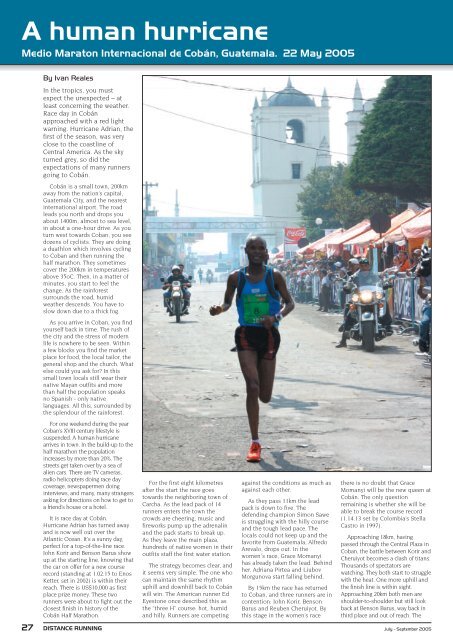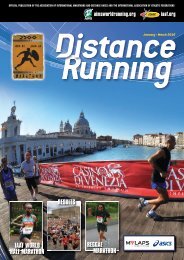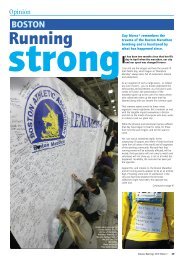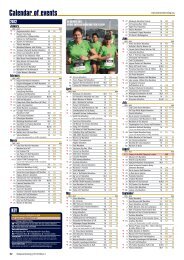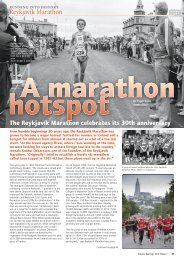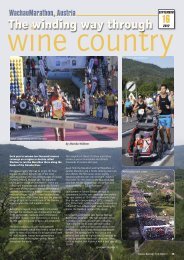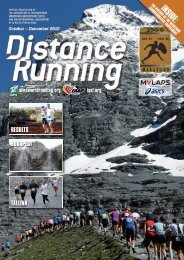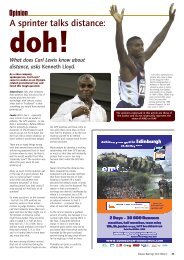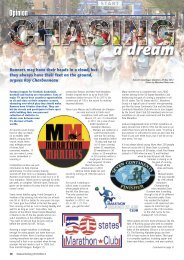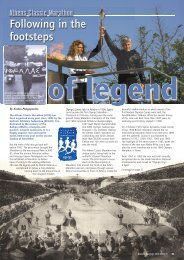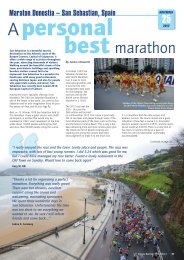Download pdf - Distance Running magazine
Download pdf - Distance Running magazine
Download pdf - Distance Running magazine
You also want an ePaper? Increase the reach of your titles
YUMPU automatically turns print PDFs into web optimized ePapers that Google loves.
A human hurricane<br />
Medio Maraton Internacional de Cobán, Guatemala. 22 May 2005<br />
By Ivan Reales<br />
In the tropics, you must<br />
expect the unexpected – at<br />
least concerning the weather.<br />
Race day in Cobán<br />
approached with a red light<br />
warning. Hurricane Adrian, the<br />
first of the season, was very<br />
close to the coastline of<br />
Central America. As the sky<br />
turned grey, so did the<br />
expectations of many runners<br />
going to Cobán.<br />
Cobán is a small town, 200km<br />
away from the nation’s capital,<br />
Guatemala City, and the nearest<br />
international airport. The road<br />
leads you north and drops you<br />
about 1400m, almost to sea level,<br />
in about a one-hour drive. As you<br />
turn west towards Coban, you see<br />
dozens of cyclists. They are doing<br />
a duathlon which involves cycling<br />
to Coban and then running the<br />
half marathon. They sometimes<br />
cover the 200km in temperatures<br />
above 35oC. Then, in a matter of<br />
minutes, you start to feel the<br />
change. As the rainforest<br />
surrounds the road, humid<br />
weather descends. You have to<br />
slow down due to a thick fog.<br />
As you arrive in Coban, you find<br />
yourself back in time. The rush of<br />
the city and the stress of modern<br />
life is nowhere to be seen. Within<br />
a few blocks you find the market<br />
place for food, the local tailor, the<br />
general shop and the church. What<br />
else could you ask for? In this<br />
small town locals still wear their<br />
native Mayan outfits and more<br />
than half the population speaks<br />
no Spanish - only native<br />
languages. All this, surrounded by<br />
the splendour of the rainforest.<br />
For one weekend during the year<br />
Coban’s XVIII century lifestyle is<br />
suspended. A human hurricane<br />
arrives in town. In the build-up to the<br />
half marathon the population<br />
increases by more than 20%. The<br />
streets get taken over by a sea of<br />
alien cars. There are TV cameras,<br />
radio helicopters doing race day<br />
coverage, newspapermen doing<br />
interviews, and many, many strangers<br />
asking for directions on how to get to<br />
a friend’s house or a hotel.<br />
It is race day at Cobán.<br />
Hurricane Adrian has turned away<br />
and is now well out over the<br />
Atlantic Ocean. It’s a sunny day,<br />
perfect for a top-of-the-line race.<br />
John Korir and Benson Barus show<br />
up at the starting line, knowing that<br />
the car on offer for a new course<br />
record (standing at 1.02.15 to Enos<br />
Ketter, set in 2002) is within their<br />
reach. There is US$10,000 as first<br />
place prize money. These two<br />
runners were about to fight out the<br />
closest finish in history of the<br />
Cobán Half Marathon.<br />
For the first eight kilometres<br />
after the start the race goes<br />
towards the neighboring town of<br />
Carcha. As the lead pack of 14<br />
runners enters the town the<br />
crowds are cheering, music and<br />
fireworks pump up the adrenalin<br />
and the pack starts to break up.<br />
As they leave the main plaza,<br />
hundreds of native women in their<br />
outfits staff the first water station.<br />
The strategy becomes clear, and<br />
it seems very simple. The one who<br />
can maintain the same rhythm<br />
uphill and downhill back to Cobán<br />
will win. The American runner Ed<br />
Eyestone once described this as<br />
the “three H” course: hot, humid<br />
and hilly. Runners are competing<br />
against the conditions as much as<br />
against each other.<br />
As they pass 11km the lead<br />
pack is down to five. The<br />
defending champion Simon Sawe<br />
is struggling with the hilly course<br />
and the tough lead pace. The<br />
locals could not keep up and the<br />
favorite from Guatemala, Alfredo<br />
Arevalo, drops out. In the<br />
women´s race, Grace Momanyi<br />
has already taken the lead. Behind<br />
her, Adriana Pirtea and Liubov<br />
Morgunova start falling behind.<br />
By 15km the race has returned<br />
to Coban, and three runners are in<br />
contention: John Korir, Benson<br />
Barus and Reuben Cheruiyot. By<br />
this stage in the women’s race<br />
there is no doubt that Grace<br />
Momanyi will be the new queen at<br />
Cobán. The only question<br />
remaining is whether she will be<br />
able to break the course record<br />
(1.14.13 set by Colombia’s Stella<br />
Castro in 1997).<br />
Approaching 18km, having<br />
passed through the Central Plaza in<br />
Coban, the battle between Korir and<br />
Cheruiyot becomes a clash of titans.<br />
Thousands of spectators are<br />
watching. They both start to struggle<br />
with the heat. One more uphill and<br />
the finish line is within sight.<br />
Approaching 20km both men are<br />
shoulder-to-shoulder but still look<br />
back at Benson Barus, way back in<br />
third place and out of reach. The<br />
27 DISTANCE RUNNING July - September 2005


